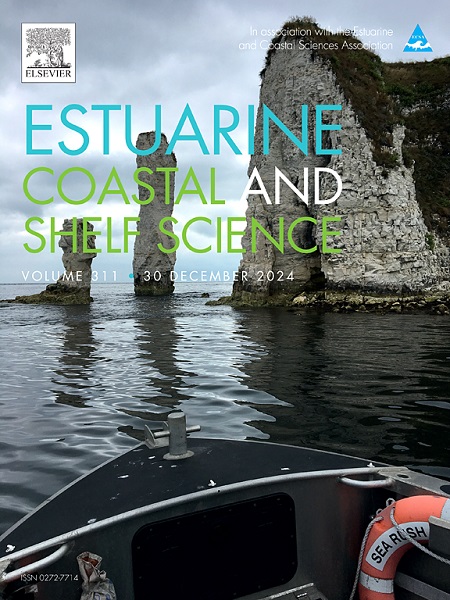Community metabolism and greenhouse gas emissions in abandoned tropical salt pans
IF 2.6
3区 地球科学
Q1 MARINE & FRESHWATER BIOLOGY
引用次数: 0
Abstract
A large area of coastal wetlands has been converted into solar salt pans over thousands of years. However, salt production declined significantly from the 20th century onward, leading to the abandonment of many salt pans globally. Coastal wetlands are generally recognized as blue carbon ecosystems, but little is known about the carbon flux of abandoned salt pans. This study aimed to assess the carbon flux of abandoned tropical salt pans, using a case study in Budai, southwestern Taiwan by measuring community metabolism and greenhouse gas (GHG) emissions. The results of community metabolism showed that the pelagic community of the salt pans is autotrophic, which is closely related to water chlorophyll a concentration. However, the benthic community is heterotrophic, which is influenced by water temperature and dissolved inorganic phosphorus concentration. The combined metabolism of pelagic and benthic communities in the salt pans exhibited an average carbon absorption of 111.5 g C m−2 yr−1. The results of GHG emissions measured with floating chambers indicated that the CO2 flux into the salt pans averaged 139.3 g CO2 m−2 yr−1, but a small amount of averaging 354.8 mg CH4 m−2 yr−1 and 136.0 mg N2O m−2 yr−1 was emitted from the salt pans. Consequently, the net GHG balance indicated that the salt pans serve as systems for removing GHG at an average rate of 92.6 g CO2e m−2 yr−1. The CO2 removal capacity of abandoned tropical salt pans performed better than that of unvegetated coastal wetlands, showing the potential to mitigate climate change.

废弃热带盐田的群落代谢和温室气体排放
数千年来,一大片沿海湿地已经变成了太阳能盐田。然而,从20世纪开始,盐的产量显著下降,导致全球许多盐田被遗弃。沿海湿地通常被认为是蓝碳生态系统,但对废弃盐田的碳通量知之甚少。本研究以台湾布代为例,通过测量热带盐田群落代谢与温室气体(GHG)排放,评估热带盐田的碳通量。群落代谢结果表明,盐田中上层群落为自养型,这与水体叶绿素a浓度密切相关。底栖生物群落是异养的,受水温和溶解无机磷浓度的影响。盐田中上层和底栖生物群落的联合代谢平均碳吸收量为111.5 g C m−2 yr−1。浮动室测量的温室气体排放结果表明,进入盐田的CO2通量平均为139.3 g CO2 m−2 yr−1,但从盐田排放的CO2通量平均为354.8 mg CH4 m−2 yr−1和136.0 mg N2O m−2 yr−1。因此,净温室气体平衡表明,盐田作为一个系统,以92.6 g CO2e m−2 yr−1的平均速率去除温室气体。废弃热带盐田对CO2的去除能力优于无植被滨海湿地,显示出减缓气候变化的潜力。
本文章由计算机程序翻译,如有差异,请以英文原文为准。
求助全文
约1分钟内获得全文
求助全文
来源期刊
CiteScore
5.60
自引率
7.10%
发文量
374
审稿时长
9 months
期刊介绍:
Estuarine, Coastal and Shelf Science is an international multidisciplinary journal devoted to the analysis of saline water phenomena ranging from the outer edge of the continental shelf to the upper limits of the tidal zone. The journal provides a unique forum, unifying the multidisciplinary approaches to the study of the oceanography of estuaries, coastal zones, and continental shelf seas. It features original research papers, review papers and short communications treating such disciplines as zoology, botany, geology, sedimentology, physical oceanography.

 求助内容:
求助内容: 应助结果提醒方式:
应助结果提醒方式:


